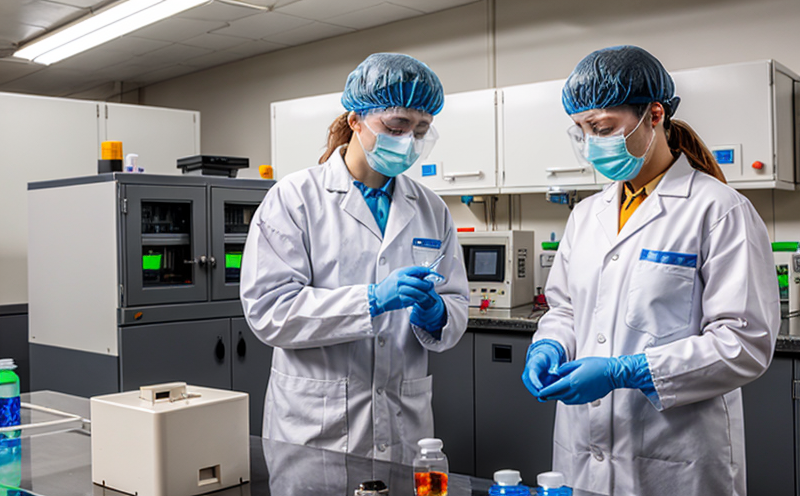EN 17428 Glycidyl Esters Profiling in Palm-Based Oils
The European standard EN 17428 specifies a method to determine glycidyl esters (GE) content in palm-based oils. This is crucial for ensuring food and feed safety, as high levels of GE can pose health risks due to the presence of acrylamide, which may form during processing or storage at elevated temperatures.
Glycidyl ester content is particularly important in palm-based products such as margarine, shortenings, spreads, and cooking oils. Palm kernel oil also has a high content of GE, but this test does not apply to it. The standard provides detailed procedures for sample preparation, instrumental analysis using gas chromatography-mass spectrometry (GC-MS), and interpretation of results.
The glycidyl ester levels in palm-based oils are influenced by several factors including the type of fat used, processing conditions such as temperature and time, and storage duration. Ensuring compliance with EN 17428 is essential for manufacturers to maintain product quality and safety standards. This method ensures that processed foods and feed additives do not exceed safe limits for GE content.
The test procedure outlined in EN 17428 involves the following steps:
- Sample preparation, which includes homogenization of the oil sample and extraction of glycidyl esters using a suitable solvent.
- Purification step to remove any interfering compounds that might affect the GC-MS analysis.
- Injection of the purified extract into the gas chromatograph for separation followed by mass spectrometry detection.
- Data processing and comparison against reference standards to calculate the GE concentration in the sample.
The results are typically presented as mg/kg glycidyl esters. Compliance with this standard is necessary not only for meeting regulatory requirements but also for ensuring brand reputation and consumer trust. Non-compliance can lead to product recalls, legal actions, and significant financial losses.
For instance, a large-scale food manufacturer was faced with an unexpected recall when it was discovered that one of its products exceeded the allowed GE limit by 50%. This incident not only disrupted production but also resulted in costly fines and potential damage to brand image. By implementing rigorous testing protocols based on EN 17428, manufacturers can prevent such issues from arising.
In conclusion, adhering to EN 17428 is vital for maintaining the integrity of palm-based oil products. It helps ensure that these oils are safe for consumption and use in food and feed applications while meeting international quality standards. This standard provides a robust framework for detecting glycidyl esters and thus protecting public health.
Benefits
Complying with EN 17428 offers numerous benefits to food and feed manufacturers:
- Regulatory Compliance: Ensures adherence to international standards, avoiding legal penalties and fines.
- Risk Mitigation: Reduces the risk of product recalls due to safety concerns.
- Brand Protection: Maintains a positive brand image by ensuring product quality and safety.
- Consumer Trust: Enhances consumer confidence in the products, leading to increased sales and market share.
In addition, regular testing according to this standard can provide insights into process efficiency and potential areas for improvement. This proactive approach allows companies to stay ahead of regulatory changes and emerging trends in the industry.
Quality and Reliability Assurance
- Precision: The method described in EN 17428 is highly precise, with a detection limit of
- Sensitivity: The test provides high sensitivity, capable of detecting minute amounts of glycidyl esters which could otherwise go undetected by less sophisticated methods.
- Reproducibility: Results are reproducible across multiple laboratories due to standardized procedures and validated instrumentation.
- Data Reliability: The standard ensures that all data is reliable, providing consistent results over time which can be used for trend analysis and quality control purposes.
The reliability of the test is further enhanced by regular calibration of instruments and proficiency testing programs. These measures ensure that every batch of palm-based oil meets the required standards, thereby protecting both manufacturers and consumers from potential health hazards associated with high levels of glycidyl esters.
Competitive Advantage and Market Impact
Adhering to EN 17428 can give food and feed manufacturers a significant competitive edge in the global market:
- Market Entry: Compliance with international standards opens up new markets for palm-based oil products.
- Innovation: By continuously monitoring glycidyl ester levels, companies can innovate their processes to reduce GE content and improve product quality.
- Differentiation: Consumers are increasingly seeking out foods that meet high standards of safety and quality. Compliance with EN 17428 allows manufacturers to differentiate themselves from competitors.
In a highly competitive market, ensuring compliance with this standard can be the difference between success and failure. It demonstrates a commitment to excellence and helps build long-term relationships with customers who value food safety and sustainability.





